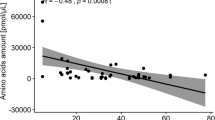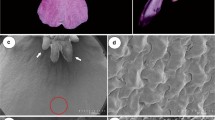Abstract
IT has been known since ancient times that nectar, usually secreted from specialized glands within flowers, is utilized by anthophilous (flower-visiting) animals for the energy-providing sugars that it contains. It is usually assumed that protein-making materials will be obtained elsewhere, from larval feeding (Lepidoptera), from pollen (Hymenoptera—Apioideae) or (by vertebrates) from insects. However, some butterflies are known to be attracted to decaying flesh, faeces, urine and stagnant water1 and well as sweat2, while many take phloem-sap from a wound or honey-dew excreted by aphids1. Moths are known to drink fruit juices, sweat, secretions from the eyes of animals, and even mammalian blood3. Unusual feeding-behaviour is shown by butterflies of the genus Heliconius which collect pollen, steep it in nectar, and subsequently ingest the amino-acids that diffuse from the grains4.
Similar content being viewed by others
References
Ford, E. B., Butterflies (Collins, London, 1945).
Hocking, B., Six-legged Science (Schenkman, Cambridge, Mass., 1971).
Bänziger, H., Fauna, 1, 4 (1971).
Gilbert, L. E., Proc. US Nat. Acad. Sci., 69, 1403 (1972).
Müller, H., Die Befruchtung der Blumen durch Insekten (Engelmann, Leipzig, 1873).
Browne, C. A., USDA Bur. Chem. Bull., 110, 1 (1907).
Lothrop, R. E., and Gertler, S. I., Ind. Eng. Chem., Anal., fifth ed., 103 (1933).
Schuette, H. A., and Baldwin, jun., C. L., Food Res., 9 244 (1944).
Pryce-Jones, J., Bee World, 31, 2 (1950).
White, jun., J. W., Bee World, 38, 57 (1957).
Percival, M. S., New Phytol., 60, 235 (1961).
Maurizio, A., Bee World, 43, 66 (1962).
Haydak, M. H., Ann. Rev. Entomol., 15, 143 (1970).
International Symposium on The Interrelations of Taxonomy and Ecology (Academic Press, London, in the press).
Author information
Authors and Affiliations
Rights and permissions
About this article
Cite this article
BAKER, H., BAKER, I. Amino-acids in Nectar and their Evolutionary Significance. Nature 241, 543–545 (1973). https://doi.org/10.1038/241543b0
Received:
Revised:
Issue Date:
DOI: https://doi.org/10.1038/241543b0
- Springer Nature Limited
This article is cited by
-
Floral nectar (FN): drivers of variability, causes, and consequences
Brazilian Journal of Botany (2024)
-
Anatomical, histochemical, and developmental approaches reveal the long-term functioning of the floral nectary in Tocoyena formosa (Rubiaceae)
The Science of Nature (2024)
-
Floral nectar reabsorption and a sugar concentration gradient in two long-spurred Habenaria species (Orchidaceae)
BMC Plant Biology (2023)
-
Sugar feeding by invasive mosquito species on ornamental and wild plants
Scientific Reports (2023)
-
Sugar Concentration, Nitrogen Availability, and Phylogenetic Factors Determine the Ability of Acinetobacter spp. and Rosenbergiella spp. to Grow in Floral Nectar
Microbial Ecology (2023)





